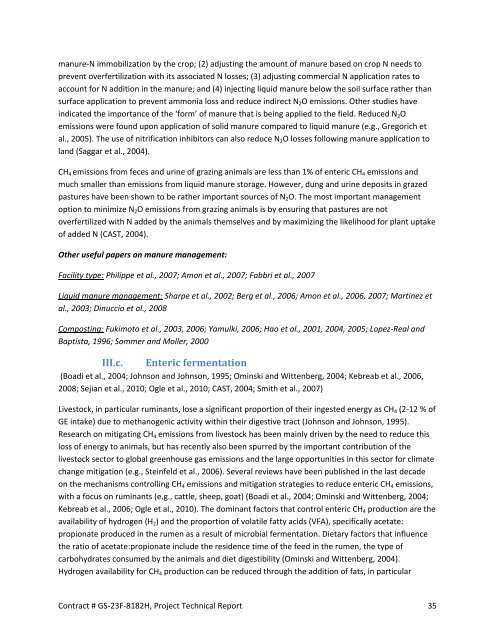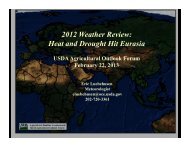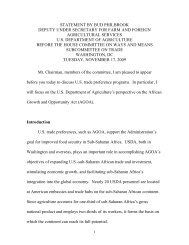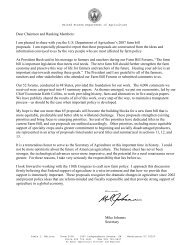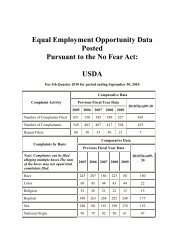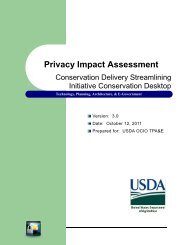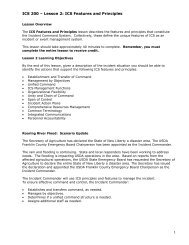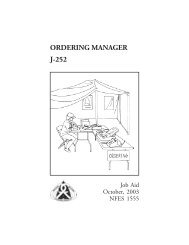Greenhouse Gas Emissions from U.S. Agriculture and Forestry: A ...
Greenhouse Gas Emissions from U.S. Agriculture and Forestry: A ...
Greenhouse Gas Emissions from U.S. Agriculture and Forestry: A ...
Create successful ePaper yourself
Turn your PDF publications into a flip-book with our unique Google optimized e-Paper software.
manure‐N immobilization by the crop; (2) adjusting the amount of manure based on crop N needs to<br />
prevent overfertilization with its associated N losses; (3) adjusting commercial N application rates to<br />
account for N addition in the manure; <strong>and</strong> (4) injecting liquid manure below the soil surface rather than<br />
surface application to prevent ammonia loss <strong>and</strong> reduce indirect N2O emissions. Other studies have<br />
indicated the importance of the ‘form’ of manure that is being applied to the field. Reduced N2O<br />
emissions were found upon application of solid manure compared to liquid manure (e.g., Gregorich et<br />
al., 2005). The use of nitrification inhibitors can also reduce N2O losses following manure application to<br />
l<strong>and</strong> (Saggar et al., 2004).<br />
CH4 emissions <strong>from</strong> feces <strong>and</strong> urine of grazing animals are less than 1% of enteric CH4 emissions <strong>and</strong><br />
much smaller than emissions <strong>from</strong> liquid manure storage. However, dung <strong>and</strong> urine deposits in grazed<br />
pastures have been shown to be rather important sources of N2O. The most important management<br />
option to minimize N2O emissions <strong>from</strong> grazing animals is by ensuring that pastures are not<br />
overfertilized with N added by the animals themselves <strong>and</strong> by maximizing the likelihood for plant uptake<br />
of added N (CAST, 2004).<br />
Other useful papers on manure management:<br />
Facility type: Philippe et al., 2007; Amon et al., 2007; Fabbri et al., 2007<br />
Liquid manure management: Sharpe et al., 2002; Berg et al., 2006; Amon et al., 2006, 2007; Martinez et<br />
al., 2003; Dinuccio et al., 2008<br />
Composting: Fukimoto et al., 2003, 2006; Yamulki, 2006; Hao et al., 2001, 2004, 2005; Lopez‐Real <strong>and</strong><br />
Baptista, 1996; Sommer <strong>and</strong> Moller, 2000<br />
III.c. Enteric fermentation<br />
(Boadi et al., 2004; Johnson <strong>and</strong> Johnson, 1995; Ominski <strong>and</strong> Wittenberg, 2004; Kebreab et al., 2006,<br />
2008; Sejian et al., 2010; Ogle et al., 2010; CAST, 2004; Smith et al., 2007)<br />
Livestock, in particular ruminants, lose a significant proportion of their ingested energy as CH4 (2‐12 % of<br />
GE intake) due to methanogenic activity within their digestive tract (Johnson <strong>and</strong> Johnson, 1995).<br />
Research on mitigating CH4 emissions <strong>from</strong> livestock has been mainly driven by the need to reduce this<br />
loss of energy to animals, but has recently also been spurred by the important contribution of the<br />
livestock sector to global greenhouse gas emissions <strong>and</strong> the large opportunities in this sector for climate<br />
change mitigation (e.g., Steinfeld et al., 2006). Several reviews have been published in the last decade<br />
on the mechanisms controlling CH4 emissions <strong>and</strong> mitigation strategies to reduce enteric CH4 emissions,<br />
with a focus on ruminants (e.g., cattle, sheep, goat) (Boadi et al., 2004; Ominski <strong>and</strong> Wittenberg, 2004;<br />
Kebreab et al., 2006; Ogle et al., 2010). The dominant factors that control enteric CH4 production are the<br />
availability of hydrogen (H2) <strong>and</strong> the proportion of volatile fatty acids (VFA), specifically acetate:<br />
propionate produced in the rumen as a result of microbial fermentation. Dietary factors that influence<br />
the ratio of acetate:propionate include the residence time of the feed in the rumen, the type of<br />
carbohydrates consumed by the animals <strong>and</strong> diet digestibility (Ominski <strong>and</strong> Wittenberg, 2004).<br />
Hydrogen availability for CH4 production can be reduced through the addition of fats, in particular<br />
Contract # GS‐23F‐8182H, Project Technical Report 35


